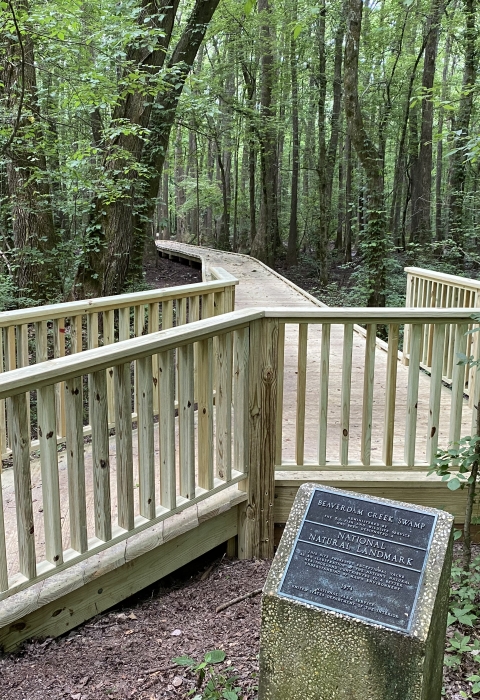Located off Old Hwy 20 south and west of the County Line Road I-565 interchange (exit 7), the ½ mile trail provides visitors access to Wheeler National Wildlife Refuge and the Beaverdam Creek Swamp National Natural Landmark (NNL). National Natural Landmarks are designated by the US Secretary of the Interior in recognition for a site’s condition, illustrative character, rarity, diversity, and value to science and education. The 580 acres that make up Beaverdam Creek NNL were designated in 1974 to recognize the pure stand of water tupelo trees found at Wheeler NWR, located within the Interior Low Plateau physiographic province. Tupelo gum swamps are more characteristic of the Gulf Coastal Plain region located further south and west in the state. Coincidently the completion of the boardwalk reconstruction in 2022 also marks marks the 60th anniversary of the National Natural Landmark program, administered by the National Park Service. In addition to Beaverdam Creek Swamp NNL, Alabama is home to an additional 6 national natural landmarks.
In 2020 the US Congress passed the Great American Outdoors Act Great American Outdoors Act
This landmark conservation law, enacted in 2020, authorizes the use of up to $1.9 billion a year in energy development revenues for five years for needed maintenance to facilities and infrastructure in our wildlife refuges, national parks, forests, recreation areas and American Indian schools.
Learn more about Great American Outdoors Act (GAOA) which provides up to five years of federal funding to repair and upgrade vital infrastructure and facilities that enrich the visitor experience, protect resources, and enable increased access to nature for visitors at federal lands across the United States. Wheeler NWR was able to save substantial construction costs by utilizing a team of Decatur-based US Fish and Wildlife Service maintenance professionals, funded by the Great American Outdoors Act, that travel to national wildlife refuges across the United States to rebuild refuge roads, trails, boardwalks, observation platforms, and other wildlife refuge infrastructure. So far at Wheeler NWR, both the Beaverdam Swamp Boardwalk and the Flint Creek Fishing Pier have been rebuilt by this local team, at considerable savings over contracting the work out. The US Fish and Wildlife Service plans to hire an additional equipment operator/maintenance employee this summer, for more information about how to apply, please send resumes to wheeler@fws.gov.
While the rebuilding of the Beaverdam Swamp Boardwalk, the Flint Creek Trail boardwalks, and the Flint Creek Fishing Pier are complete, contractors continue to work on public-use improvements including: a new 5-mile multiuse trail, a new wildlife photography blind, a new outdoor education classroom, interior upgrades to the Visitor Center and Observation Buildings, new Visitor Center exhibits, and a kayak put-in at Red Bank Road (Flint Creek). The refuge hopes to have most of this work completed by the end of the calendar year, check our refuge website for updates.
During the Visitor Center construction closure, the refuge will not operate an in-person visitor contact station. Refuge information, maps, and trail guides will be available at the information kiosk located outside the visitor center gate off the south side of Highway 67. Visitors needing further assistance should call the refuge at (256) 350-6639 Monday-Thursday, 9:00am - 4:00pm. We appreciate everyone’s patience as we construct these visitor-use enhancements as safely and efficiently as possible.
Wheeler NWR provides 35,000 acres of wetlands, fields, and forest habitat for migrating, nesting, and wintering birds. In addition to conserving habitat for wildlife, the refuge provides public access for wildlife-dependent recreation such as: fishing, hunting, wildlife observation, wildlife photography, interpretation, and environmental education.
Wheeler NWR is one of over 560 national wildlife refuges across the United States administered by the U.S. Fish and Wildlife Service. The mission of the National Wildlife Refuge System is to administer a national network of lands and waters for the conservation, management, and where appropriate, restoration of the fish, wildlife and plant resources and their habitats within the United States for the benefit of present and future generations of Americans.




